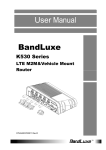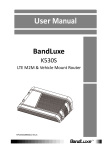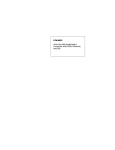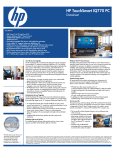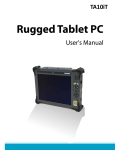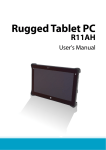Download Durabook T7Q Standard
Transcript
Table of Contents COPYRIGHT ................................................................................................. 4 REGULATORY STATEMENT ................................................................................. 4 Federal Communications Commission Statement .......................................................................................................... 4 Declaration of Conformity ............................................................................................................................................... 4 RF exposure warning........................................................................................................................................................ 5 Canada, Industry Canada (IC) Notices ........................................................................................................................... 5 Battery Disposal................................................................................................................................................................ 6 SAFETY INSTRUCTIONS ................................................................................... 7 BEFORE YOU START ................................................................ 9 PACKAGE CONTENTS ...................................................................................... 9 FEATURES ................................................................................................. 10 COMPONENTS ............................................................................................ 11 Front View ....................................................................................................................................................................... 11 Back View ........................................................................................................................................................................ 13 Left View .......................................................................................................................................................................... 13 Right View........................................................................................................................................................................ 14 Top View .......................................................................................................................................................................... 14 Bottom View..................................................................................................................................................................... 15 Status Indicators.............................................................................................................................................................. 15 GETTING STARTED ................................................................ 16 POWERING UP YOUR TABLET PC ...................................................................... 16 Connecting the AC Adapter............................................................................................................................................ 16 Using Battery Power ...................................................................................................................................................... 16 INSTALLING THE BATTERY............................................................................... 17 Charging the Battery ...................................................................................................................................................... 17 Charging Time ................................................................................................................................................................ 17 Checking the Battery Level............................................................................................................................................. 18 When to replace the Battery Pack .................................................................................................................................. 18 Removing the Battery...................................................................................................................................................... 18 STARTING YOUR TABLET PC............................................................................ 19 Turning On Your Tablet PC ........................................................................................................................................... 19 Changing the Display Orientation ................................................................................................................................. 19 Shutting Down Your Tablet PC...................................................................................................................................... 19 USING THE STYLUS ...................................................................................... 20 Calibrate the Screen ....................................................................................................................................................... 20 USING THE ON-SCREEN KEYBOARD .................................................................. 21 USING THE QUICK MENU ............................................................................... 22 USING THE CAMERA ..................................................................................... 24 USING THE MEMORY CARDS ........................................................................... 28 Inserting a Memory Card ............................................................................................................................................... 28 2 Removing a Memory Card ............................................................................................................................................. 28 MAKING CONNECTIONS ........................................................ 29 CONNECTING USB DEVICES ........................................................................... 29 CONNECTING PERIPHERAL DEVICES................................................................... 30 CONNECTING TO WIRELESS CONNECTIONS .......................................................... 31 Connecting to a Wireless Local Area Network .............................................................................................................. 31 Connecting to a Bluetooth Device ................................................................................................................................. 32 POWER MANAGEMENT .......................................................... 33 USING THE POWER PLAN ............................................................................... 33 USING THE POWER SAVING MODE .................................................................... 34 USING THE BIOS SETUP UTILITY .......................................... 35 BIOS SETUP MENU ..................................................................................... 35 STARTING THE BIOS SETUP UTILITY ................................................................. 35 NAVIGATING AND ENTERING INFORMATION IN BIOS............................................... 36 MAIN MENU .............................................................................................. 36 ADVANCED MENU ........................................................................................ 37 BOOT MENU .............................................................................................. 37 SECURITY MENU ......................................................................................... 38 SAVE & EXIT MENU ..................................................................................... 38 TROUBLESHOOTING .............................................................. 39 SPECIFICATIONS .................................................................. 40 Preface Copyright Copyright© 2012. All rights reserved. No part of this user manual may be transmitted, stored in a retrieval system, or translated into any language or computer language, in any form or by any means, without the prior written permission of the manufacturer. Information is subject to change without prior notice. Regulatory Statement Federal Communications Commission Statement This equipment has been tested and found to comply with the limits for a Class B digital device, pursuant to Part 15 of the FCC Rules. These limits are designed to provide reasonable protection against harmful interference in a residential installation. This equipment generates, uses, and can radiate radio frequency energy and, if not installed and used in accordance with the instructions, may cause harmful interference to radio communications. However, there is no guarantee that interference will not occur in a particular installation. If this equipment does cause harmful interference to radio or television reception, which can be determined by turning the equipment off and on, the user is encouraged to try to correct the interference by one or more of the following measures: Reorient or relocate the receiving antenna. Increase the separation between the equipment and the receiver. Connect the equipment into an outlet on a circuit different from that to which the receiver is connected. Consult the dealer or an experienced radio/TV technician for help. Shielded interconnect cables and shielded AC power cable must be employed with this equipment to insure compliance with the pertinent RF emission limits governing this device. Changes or modifications not expressly approved by the system's manufacturer could void the user's authority to operate the equipment. Declaration of Conformity This device complies with part 15 of the FCC rules. Operation is subject to the following conditions: This device may not cause harmful interference This device must accept any interference received, including interference that may cause undesired operation. 4 Preface RF exposure warning This equipment must be installed and operated in accordance with provided instructions and must not be co-located or operating in conjunction with any other antenna or transmitter. End-users and installers must be provided with antenna installation instructions and transmitter operating conditions for satisfying RF exposure compliance. SAR Value: 1.53 W/kg This device is operation in 5.15 – 5.25GHz frequency range, then restricted in indoor use only, Outdoor operations in the 5150~5250MHz is prohibit. This device is slave equipment, the device is not radar detection and not ad-hoc operation in the DFS band. Canada, Industry Canada (IC) Notices This Class B digital apparatus complies with Canadian ICES-003 and RSS-210. Operation is subject to the following two conditions: (1) this device may not cause interference, and (2) this device must accept any interference, including interference that may cause undesired operation of the device. Radio Frequency (RF) Exposure Information The radiated output power of the Wireless Device is below the Industry Canada (IC) radio frequency exposure limits. The Wireless Device should be used in such a manner such that the potential for human contact during normal operation is minimized. This device has been evaluated for and shown compliant with the IC Specific Absorption Rate (“SAR”) limits when installed in specific host products operated in portable exposure conditions. Canada, avis d'Industry Canada (IC) Cet appareil numérique de classe B est conforme aux normes canadiennes ICES003 et RSS-210. Son fonctionnement est soumis aux deux conditions suivantes : (1) cet appareil ne doit pas causer d'interférence et (2) cet appareil doit accepter toute interférence, notamment les interférences qui peuvent affecter son fonctionnement. Informations concernant l'exposition aux fré quences radio (RF) La puissance de sortie émise par l’appareil de sans fil est inférieure à la limite d'exposition aux fréquences radio d'Industry Canada (IC). Utilisez l’appareil de sans fil de façon à minimiser les contacts humains lors du fonctionnement normal. 5 Preface Ce périphérique a été évalué et démontré conforme aux limites SAR (Specific Absorption Rate – Taux d'absorption spécifique) d'IC lorsqu'il est installé dans des produits hôtes particuliers qui fonctionnent dans des conditions d'exposition à des appareils portables. Battery Disposal THIS PRODUCT CONTAINS A LITHIUM-ION OR NICKEL-METAL HYDRIDE BATTERY. IT MUST BE DISPOSED OF PROPERLY. CONTACT LOCAL ENVIRONMENTAL AGENCIES FOR INFORMATION ON RECYCLING AND DISPOSAL PLANS IN YOUR AREA. ANNEX IV Symbol for the marking of electrical and electronic equipment The symbol indicating separate collection for electrical and electronic equipment consists of the crossed-out wheeled bin, as shown below. The symbol must be printed visibly, legibly and indelibly. 6 Preface Safety Instructions Always keep strong magnetic or electrical objects away from your tablet PC. DO NOT use or store your tablet PC in extreme temperatures. DO NOT place your tablet PC near fire or other sources of heat. DO NOT expose to dust or corrosive materials. DO NOT tamper the battery. Keep it away from children. DO NOT expose your tablet PC to sudden changes in temperature or humidity. Keep your tablet away from air conditioners or heating vents. DO NOT attempt to service your tablet PC yourself. Any attempt to do so will make the warranty invalid. When servicing, refer to qualified service personnel. For better environmental protection, waste batteries should be collected separately for recycling or special disposal. 7 Preface To avoid exposed skin, such as the User’s lap, held or touched for long periods due to bottom enclosure may cause the injury from heat after long time usage. CAUTION FOR ADAPTER THIS TABLET PC IS FOR USE WITH DEDICATED AC ADAPTER. BATTERY SAFETY DANGER OF EXPLOSION IF BATTERY IS INCORRECTLY REPLACED. REPLACE ONLY WITH THE SAME OR EQUIVALENT TYPE RECOMMENDED BY THE MANUFACTURER. DISPOSE OF USED BATTERIES ACCORDING TO THE MANUFACTURER'S INSTRUCTIONS. 8 Before You Start Before You Start Congratulations on your purchase of this tablet PC. This rugged tablet PC is portable and provides users with maximum mobile computing experience in a wide range of working environments. Before you begin using your tablet PC, read this chapter to familiarize yourself with the main components installed in the system. Package Contents The following items come with your package. If any of them is damaged or missing, please contact your retailer. Tablet PC Power cord Power adapter Stylus Pen Desktop Cradle LTE Antenna Hand-strap NOTE The pictures are for reference only, actual items may slightly differ. 9 Before You Start Features Intel Cedar Trail-M platform Operating system supports Microsoft® Windows 7 and Window 8 7” WSVGA TFT Touch LCD display Small size and light weight Spill and Dust Proof Rugged design, up to military standard (MIL-STD 810G) Built-in 5MP camera Support G-sensor for LCD auto-rotation Intel WLAN capability Bluetooth connectivity WWAN Optional integrated barcode scanner (support 1D/2D barcode reading) Optional RFID reader (support ISO 15693, 14443A/B stand) 10 Before You Start Components Front View No. Item Description 1 Light sensor Use to detect the current level of visible light in the surrounding environment. 2 Status Indicators (Power, Battery, HDD, Wireless) Indicate the corresponding function status. See “Status Indicators” on page 15. 3 Speaker Emit sound. 4 Power Press to power on and off the tablet PC. 5 Scanner Press to trigger the Barcode scan function. 6 Camera Press to activate the Camera Application. 7 Stealth mode Press to disable all emitting lights and sound. 8 Quick menu Press to access the Quick menu. 9 Security Press to exit Windows and enter SAS (Secure Attention Sequence) mode. 11 Before You Start No. 10 Item Description NumLock Press to emulate NumLock key. NOTE When the numerical mode is activated, the keypad backlight (blue) lights on. If the keypad is left idle for 60 seconds, the backlight will automatically turn off. 11 Program1 Press to access your favorite programs. 12 Enter Press to emulate the Enter key. 13 Program2 Press to access your favorite programs. 14 Arrow (up) Press to emulate the Up key. 15 Arrow (left) Press to emulate the Left key. 16 Arrow (right) Press to emulate the Right key. 17 WLAN (Wi-Fi and Bluetooth) Press to activate wireless LAN or Bluetooth communication. 18 Arrow (down) Press to emulate the Down key. 19 Rotate Press to rotate the display. 20 Number (0) Press to enter 0. 12 Before You Start Back View No. Item Description 1 Camera LED flash Provide additional lighting when taking pictures under the low light environment. 2 Camera Use to take pictures. 3 Battery compartment Contain the battery. 4 Battery latch Lock the battery in place. Left View No. Item Description 1 Kensington lock slot Connect to a Kensington-compatible tablet PC security lock. 2 DC-in jack Connect the power adapter. 13 Before You Start Right View I/O A No. I/O B Item Description 1 Serial port (RS-232/RS-485) Connect a peripheral device, such as a printer or other device with serial port. 2 LAN (RJ-45) port Connect to a local area network (LAN) using an Ethernet cable. 3 USB port(s) Connect USB peripheral devices. Top View No. Item Description 1 ExpressCard slot and PC Card slot Use to insert one 34/54 ExpressCard or Type II PC Card. 2 Card reader Use to insert memory cards to transfer pictures, music, and data between your tablet PC and flash compatible devices. The card reader supports SD (Secure Digital), SDHC, Mini-SD (with adapter), MMC (Multi-media card), MMC+, Mini-MMC (with adapter) cards. 14 Before You Start Bottom View No. 1 Item Description Docking station port Connect the tablet PC to a docking station. Status Indicators The status indicators in the upper left corner of the keyboard light up when a particular function of the tablet PC is active. Each indicator is marked with a symbol. Icon Item Description Power The LED always lights on (green) when the system is running. When the system is in sleep mode, the LED blinks. Battery Indicate the battery status: Green light means the battery is fully charged. Orange light means the battery is being charged. Blinking orange light means the OTP of the battery pack is activated. Red light means the battery power is low. HDD A blinking green LED indicates HDD activity (data is being read or written). WLAN Indicate the status of wireless LAN or Bluetooth communication. The LED always lights on (blue) when the function is enabled. 15 Getting Started Getting Started This chapter will guide you on how to use your tablet PC. Powering Up Your Tablet PC Your tablet PC can be powered up using the AC adapter or the Lithium-ion battery. Connecting the AC Adapter The AC adapter powers up your tablet PC and charges the battery. 1. Connect the AC adapter to the DC-in jack of your tablet PC. 2. Connect the AC adapter to the power cord. 3. Plug the power cord to an electrical outlet. Using Battery Power 1. Install a charged battery in the battery compartment. 2. Remove the AC adapter (if plugged). Your tablet PC will automatically use the battery power. 16 NOTE If your tablet PC is connected to an electrical outlet and the battery is installed, your tablet PC uses power from the electrical outlet. Getting Started Installing the Battery To install the battery, follow the steps below: 1. Align and insert the battery to the battery compartment. 2. Push completely until the battery locks into place. 3. Slide the battery latch to the lock position to secure the battery. Charging the Battery The Lithium-ion battery is not fully-charged upon purchase. To charge the battery, follow the steps below: 1. Install the battery to your tablet PC. See procedures above. 2. Connect the AC adapter to the DC-in jack of your tablet PC. 3. Connect the AC adapter to the power cord. 4. Plug the power cord to an electrical outlet. Charging Time Number of battery pack Charging duration (at 25ºC) 1 2 3.5 hours 6.5 hours NOTE The charging time may be longer if you are using your tablet PC while charging the battery. CAUTION DO NOT charge the battery if the temperature is below 0ºC or higher than 50ºC. Use only the supplied AC adapter. Using other AC adapters may damage the battery or your tablet PC. 17 Getting Started Checking the Battery Level It is important that you monitor the battery status regularly to ensure you do not run out of power at a critical moment. To check the remaining battery power, double tap the battery icon in the system tray. The battery screen appears: When to replace the Battery Pack The battery performance gradually decreases over time and usage. We recommend you to replace your battery pack after 18 to 24 months of usage. Removing the Battery To remove the battery, follow the steps below: Slide the battery latch to the unlock position. 18 Remove the battery out of the battery compartment. NOTE Make sure the system has shut down before you change the battery. Getting Started Starting Your Tablet PC Turning On Your Tablet PC Press the button until the Power LED lights up. Changing the Display Orientation You can rotate the display orientation to suit your preference. Press the button to rotate the display 90° clockwise. Shutting Down Your Tablet PC It is important to properly shut down your tablet PC to avoid the loss of unsaved data. To shut down your tablet PC, do the following: Tap Start > Shut down. Wait for your tablet PC to turn off power completely before removing the power source (if necessary). 19 Getting Started Using the Stylus This tablet PC comes with an integrated stylus for accurate control input to the LCD touch panel and digitizer. You can use the stylus to point, select, or drag items or objects on the screen. Calibrate the Screen To ensure touch accuracy, calibrate the screen. 1. Tap Start > Control Panel. 2. Select Tablet PC Settings. 3. Tap Calibrate. 4. Follow the on-screen instructions to complete screen calibration. 20 Getting Started Using the On-Screen Keyboard Tap the screen to activate the on-screen keyboard and drag it out to the center of the screen to bring up the on-screen keyboard. Standard Keyboard Tap the keys on the keyboard just as you would on a hardware keyboard. To toggle between standard and expanded keyboard, tap Tools > Show expanded keyboard. When keys are pressed, the on-screen keyboard predicts the word as you type. Word suggestions appear on top of the keyboard. Tap a word to select it. To enter text by handwriting, tap the Handwriting icon ( keyboard mode, tap the Keyboard icon ( ). To go back to ). 21 Getting Started Using the Quick Menu Press the button to enter the Quick menu. 1 2 3 4 13 12 11 5 6 10 7 8 9 No. Item Description 1 WLAN Tap the icon to enable/disable the Wi-Fi (WLAN) function. 2 WWAN Tap the icon to enable/disable the WWAN function. 3 Bluetooth Tap the icon to enable/disable the Bluetooth function. 4 GPS Tap the icon to enable/disable the GPS function. 5 Auto-rotate Tap the icon to enable/disable the Auto-Rotate screen function. 6 Keypad Backlight 7 Setup Tap the icon to turn the keypad backlight on/off. Tap the icon to set hotkey, serial port, light sensor, and keypad backlight settings. 22 NOTE The Keypad Backlight option is only available when the keypad backlight is enabled. Getting Started No. Item Description 8 Information Tap the icon to view the battery charge cycle, Bios version, EC version, and Quick Menu version. 9 Keyboard Tap the icon to display/hide the on-screen keyboard. 10 Mobility center Tap the icon to adjust brightness, screen orientation, volume, external display, battery status, sync, wireless network, and presentation settings. 11 Barcode Tap the icon to trigger the Barcode Scanner power ON/OFF. 12 RFID Tap the icon to trigger the RFID power ON/OFF. 13 Airplane mode Tap the icon to enable/disable airplane mode. NOTE When the Airplane mode is enabled, the wireless network (WLAN and WWAN), Bluetooth, and GPS will be automatically disabled. NOTE If the icon is gray (i.e. ), this indicates the current function is disabled. 23 Getting Started Using the Camera This tablet PC supports Durabook Camera Scan application that enables users to take photos using the device camera. Launch the application There are two ways to launch the application: Double-click “DuraBook Camera Scan” Tap Start > All Programs > DuraBook. on desktop. unknown Take Photos Press the Record button to capture the pictures. View Photos Press the Forward or Backward button “ Press the Play button “ In Playback mode, press the Preview button “ mode. 24 / ” to view the recorded photos. ” to switch to Playback mode. ” to switch back to Camera Getting Started Delete Photos 1. Press the Play button “ ” to switch to Playback Mode. 2. Use the Forward or Backward button “ / ” to select the photo that you want to delete. 3. Press the Delete button “ ” and then choose Yes to delete the current photo. Record GPS Coordinates (Geotagging) is the GPS signal status located on the top right corner of the main program. GPS device must be implemented in the system for locating the positions and recording the coordinates when capturing photos. If GPS coordinates are not able to be received, the last coordinates would be used instead. GPS status indicator GPS device is working properly GPS device is not available GPS signals are unstable If the user decided to use the external USB GPS device, do the following: 1. 2. 3. Press the Setup button “ ” to enter the Setup menu. Tap > Auto Scan Comport. The detected Port Number is displayed on the screen. 25 Getting Started How to Make Adjustments on Features: Press the Setup button “ ” to enter the Setup menu. Camera Selection: There are three cameras that you can select: “ ” – the camera is available and ready to use. “ ” - the camera is not available. Press the Leave button “ . ” after you have chosen the desired camera. Resolution: There are four resolution options that you can select: . If the Camera does not support these four resolutions, a “Change Resolution Error” message will appear on the screen. Press the Leave button “ ” to exit. (Native: maximum resolution) 26 Getting Started Preview Size: There are two preview size options that you can select: Press the Leave button “ . ” after you have chosen the desired preview size. Geotagging: Tap ON to enable the Geotagging feature. Press the Leave button “ ” to exit. NOTE The Geotagging feature will only be activated if the tablet PC is equipped with the GPS module. The camera logs the GPS position accurately if photos are taken outdoor. Flash: When capturing photos under the low light environment, tap ON to turn on the LED Flash. NOTE The effective flash range is 50cm. Idle Timing: There are five Idle Timing options that you can select: . Press the Leave button “ ”after you have chosen the desired time. NOTE When the system is left idle for a certain period of time, the camera module(s) would then stop running. It would be up and running again once user wakes up the “DuraBook” application. 27 Getting Started Using the Memory Cards Your tablet PC supports different types of memory cards to provide faster data transfer. Supported types are as follows: SD card SDHC card Mini-SD card (with adapter) MS card (Memory Stick/PRO) MMC card Mini-MMC card (with adapter) Inserting a Memory Card With the label side up, push the memory card into the memory card slot until it clicks into place. Removing a Memory Card It is important to remove the memory card properly. Improper removal may cause the data in the memory card to be corrupted and your tablet PC to malfunction. To properly remove the memory card, follow the steps below: 1. Tap the removable disk icon on the system tray. 2. Tap Eject SD Card. The system confirms that the device can be safely removed. 3. Push the memory card to eject it. 4. Pull the card out from the slot. 28 Making Connections Making Connections This chapter will guide you on installing peripheral devices to maximize the use of your tablet PC. Connecting USB Devices You can connect your tablet PC to other USB devices, such as a mouse, keyboard, digital camera, printer, or an external hard disk drive. 1. Connect one end of a USB cable to the USB port of your tablet PC. 2. Connect the other end to the USB device (if necessary). NOTE The USB cable is not included in the package. It is sold separately or it may come with your USB device. 29 Making Connections Connecting Peripheral Devices You can connect your tablet PC to other peripheral devices, such as a printer or other device with serial port. 1. Connect one end of an RS-232 cable to the RS-232 port of your tablet PC. 2. Tighten the two screws on the side of the cable plug with your fingers. 3. Connect the other end to the RS-232 port of a printer or other peripheral device. 30 NOTE The RS-232 cable is not included in the package. It is sold separately. Making Connections Connecting to Wireless Connections You can connect your tablet PC to a wireless local area network, WWAN, Bluetooth, or GPS. Before using a wireless built-in device, you need to turn the respective built-in wireless functions on. Connecting to a Wireless Local Area Network Your tablet PC comes with a WLAN module. A wireless network can be added either when the network is detected or by manually entering the settings information. To connect, follow the steps below: 1. Press the button to turn on the wireless network function. NOTE You can also activate the wireless network function by tapping icon in the Quick menu. 2. Tap the wireless network icon on the system tray. 3. Available wireless network connections are displayed. Tap the desired wireless network. 4. Tap Connect. Some networks require a network security key or a password. TIP 4. Check Connect automatically box to automatically connect to this network when it is available. 6. Enter the network security key. 7. Tap OK. 8. After the connection is established, you can see the wireless icon ( Notification area. ) in the NOTE Wi-Fi access requires service from a wireless service provider. Contact your service provider for more information. Actual wireless connectivity will depend on system configuration. Please contact your dealer for more information. 31 Making Connections Connecting to a Bluetooth Device Your tablet PC can connect and communicate with other Bluetooth-enabled devices. To add a device, follow the steps below: 2. Press the button to turn on the wireless network function. NOTE You can also activate the wireless network function by tapping icon in the Quick menu. 3. Tap the arrow on the system tray to display hidden icons. 4. Tap the Bluetooth icon. 5. Tap Add a Device. The system starts scanning for Bluetooth devices and displays the available devices. 6. Tap on a device, then tap Next. 7. Enter the passkey (PIN) to start pairing, and tap Next. 8. After the pairing process is complete, tap Close. 32 NOTE The PIN you enter on the tablet PC must be the same PIN to be entered on the other Bluetooth device. Once a partnership has been created, connecting to that device again will no longer require entering the PIN. Power Management Power Management This chapter will guide you on how to manage the system power. Using the Power Plan To improve energy efficiency, you can use the power plan to reduce the amount of power your tablet PC uses, maximize the performance, or balance the two. 1. Tap Start > Control Panel. 2. Select Power Options. 3. Select a power plan. 4. To adjust the selected power plan settings, tap Change plan settings. 33 Power Management Using the Power Saving Mode When you are not using the tablet PC, turn off the tablet PC or set the tablet PC to enter sleep mode. To set the tablet PC to enter sleep mode, follow the steps below: 1. Tap Start. 2. Select Shut down > Sleep. To wake up the tablet PC from sleep mode, do one of the following: Press the Press any key on the external keyboard. 34 button. Using the BIOS Setup Utility Using the BIOS Setup Utility Your tablet PC has a BIOS setup utility which allows you to configure important system settings, including settings for various optional functions of the tablet PC. This chapter explains how to use the BIOS setup utility. BIOS Setup Menu The BIOS Setup Utility allows you to configure your tablet PC basic settings. When you turn your tablet PC on, the system reads this information to initialize the hardware so that it can operate correctly. Use the BIOS setup utility to change your tablet PC start-up configuration. For example, you can change the security and power management routines of your system. Starting the BIOS Setup Utility You can only enter the BIOS setup utility as the tablet PC is booting, that is between the time you turn on the tablet PC and before the Windows interface appears. If your tablet PC is already on, shut down your tablet PC completely (power off) and restart it and then press the Delete key to enter the setup utility. NOTE You have to connect your tablet PC with an external keyboard first before starting the BIOS Setup Utility. 35 Using the BIOS Setup Utility Navigating and Entering Information in BIOS Use the following keys to move between fields and to enter information: Function Key Description Selects screen. Moves up/down to select items. Enter +/F1 F2 F3 F4 Confirms the selection and enters the selected menu screen. Changes an option for the selected items. Displays the Help screen. Invokes the previous values. Loads optimized default values. Saves the changes and exits Setup. Press Esc to exit any section. If you wish to exit the BIOS utility Esc without saving changes, go to the main menu, then press Esc. Users are allowed to enter new values to replace the default settings in certain fields, and the rest of the fields are specified by system default parameters and cannot be modified by users. Reverse the attribute of the main options and press Enter to enter into the submenu. Press Esc to return to the previous configuration page. Main Menu The Main menu displays the system overview information about BIOS version, CPU features, and total memory size. You can also set the system date and time. 36 Using the BIOS Setup Utility Advanced Menu The Advanced menu allows you to calibrate the battery and configure wake up event, external speaker/microphone, keypad backlight timer, serial port, fast flash standby, and RF device control settings. Boot Menu The Boot menu allows you to configure the boot type and boot sequence. 37 Using the BIOS Setup Utility Security Menu The Security menu allows you to set or change the Administrator and User passwords, and configure TPM settings. Save & Exit Menu The Save & Exit menu allows you to save or discard the changes, or restore the default values for all setup options before leaving the BIOS Setup Menu. 38 Troubleshooting Troubleshooting This chapter contains a list of common problems that you might experience when using your tablet PC, and techniques to try and overcome the problem. If you need additional help, contact your retailer. Problems The battery isn’t charging. The screen suddenly turns blank. The tablet PC cannot connect to Internet. Nothing happens when I press the Power button. The tablet PC cannot resume from hibernate or standard mode. The tablet PC does not produce any sound. Solutions • Check if the power adapter is properly connected. • Make sure that the battery is within the recommended charging temperature of -20°C to 50°C. The brightness control is not properly set. Adjust the LCD screen brightness. Your tablet PC might be in standby or hibernate mode. Press the Power button to wake the system. If using the battery, the battery may be depleted. Replace with a fully charged battery or connect the power adapter to an electrical outlet. If using wireless, check if your location is out of range of the network. Move your tablet PC closer to the access point. If the network you are connecting to requires a security password, make sure you enter the correct password. Check to make sure the settings configurations are correct. Check if the power adapter is connected to an electrical outlet. If using a battery pack, make sure it has enough power. Otherwise, replace the battery. The battery power level might be too low. Connect the power adapter to an electrical outlet or replace the battery. Audio has been muted. Tap on the Speaker icon on the right of your Windows taskbar. When the volume control box appears, drag the bar to adjust the volume. 39 Specifications Specifications Features Specifications Type & Speed Processor Intel Atom Processor N2600 (1.6GHz) (Cedarview-M) Intel Atom Processor N2800 (1.86GHz) (Cedarview-M) Install Mechanism BGA Core Logic Intel NM10 Level 2 Cache 512KBx2 System Memory Type DDRIII 800 Capacity One 204-pin DDRIII SODIMM socket for 2GB Maximum Memory 2GB LCD Display & Touch Panel Display Light Sensor G-Sensor Storage 40 SSD Standard: 7” WSVGA (1024x 600 resolution) TFT LCD with resistive touch screen panel, LED backlighting, Brightness: 265nits (typical); 207nits (minimum) Sunlight Readable: 7” WSVGA (1024x 600 resolution) TFT LCD with Sunlight readable function, resistive touch panel with circular polarizer, Brightness: 441nits (typical); 397nits (minimum) All the glasses of touch panel are tempered glass Build-in ambient light sensor to adjust LCD brightness with 3 modes (Max. for outdoor, Middle for indoor, and Low light modes when light sensor is enabled). The setting can be disabled in Quick Menu. Support G-Sensor for LCD auto-rotation m-SATA SSD 32G/40G/64G/80G/128G m-SATA SSD is a CTO option Specifications Features Specifications Integrated 5.0 Mega Pixel camera at the back of the unit With LED support light with 1500mcd, viewing angle 120º LED support light can be triggered when taking a photo by specific application software Stable image: -15 ~ 40℃ Support GeoTagging in the EXIF of JPEG file Optional integrated bar code scanner support 1D/2D bar code reading Angle: 38.9° (Horizontal), 25.4°(Vertical) Range: 3.4-83cm Print contrast: Min. 25% Ambient light condition: 0~ 100,000 Lux Need beep sound in reading Optional RFID reader support ISO 15693, 14443A/B stand (Support N2600 CPU only)(work within 2cm) Optional digitizer and active stylus pen System support auto-switch pointing device between resistive touch panel and digitizer if available Integrated 10/100/1000 Ethernet network (RJ45) Intel Centrino Wireless N6235 ( WLAN 2x2 a/b/g/n), (Bluetooth 4.0) Global positioning system (GPS) receiver (CTO option) Support BT 4.0 Support barcode scanner and/or RFID I/O A: USB x1, RS-232/RS-485 (Fullduplex, and support 5 Voltage) x1, RJ-45 x1(add one internal USB connector) Can be replaced by another option: I/O B: RS-232 x1, USB x2, one internal USB connector (T7Q does not support barcode scanner when I/O B is installed) One docking connector located at the bottom DC-in Jack One 5pin USB interface connector besides Camera I/O Devices Barcode scanner RFID Digitizer Network/ Wireless Communications GPS Bluetooth I/O Ports Standard 41 Specifications Features Specifications Audio AC Adapter Power Battery Pack Environment Dimensions Temperature / Humidity the SD card slot Intel High Definition Audio One speaker, sound pressure 65dB at 0.5M Average at 0.8, 1K, 1.2K, and 1.5KHz with nominal power Mic. Array (Microphone x2) Output: 19V, 3.42A; 65W Input: 100V-240V, 50Hz-60Hz, Plug type: L shape Plug length and diameters: 12mm, 5.5mm Lithium Ion battery pack (7.4V, 5200mAh, 38.48W) Operating Temperature (with Adapter or battery, not boot up): -20℃~ 55℃(Test Method: MIL-810G 501.5 Procedure II) Boot-Up Temperature on Battery (with fully charged battery only, extended temp SSD): 0℃~ 55℃ Boot-Up Temperature on adapter or external power via dock (extended temp SSD): -20℃~ 55℃ Storage Environment Temperature: -51℃~71℃ (Test Method: High temperature Storage, MIL810G,Method 501.5 Procedure I climatic category A1 – Hot Dry. Low temperature Storage, MIL-STD810G,Method 502.5,Procedure I climatic category C3 – Severe Cold.) Operating Humidity: 5% ~ 95% (based on QRS test condition) 225 x 145 x 40.8 mm (excluding bumpers) 230 x 150 x 44.8 mm (including bumpers) Weight 1.3kg (with a battery and weight may vary depending on actual configuration) Specifications are subject to change without prior notice. 42











































